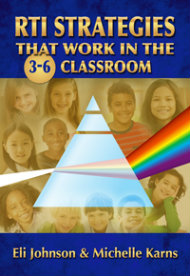RTI: More theory than practice
RTI Strategies that Work in the 3-6 Classroom
By Eli Johnson & Michelle Karns
(Eye on Education, 2012 Learn more)
Johnson and Karns identify 25 key strategies for Response to Intervention (RTI). They have very good research to back up their strategies. This book brings many research topics into one place.
The most helpful portions of this book were the “Question Aloud Guiding Questions” (p. 91) for math and the “Structured Group Discussion Sentence Frames” (p. 133) for speaking intervention strategies. These were very concrete strategies that I could implement immediately with students.
The first chapter focuses on the research regarding the 25 strategies for RTI. It was an overwhelming read for a classroom teacher. Then the beginning of each chapter returns to the research already discussed. I prefer one or the other.
 A Lack of Specificity
A Lack of Specificity
As a classroom teacher, I was looking for some very specific suggestions on how to improve my teaching and students’ learning. The authors’ steps were numbered and easy to read. However, they lacked specificity. More examples of how these steps were applied in the classroom along with student examples would have been helpful. My fifth graders would not have come up with the vocabulary that was used as an example for the “Academic Language Graphic Organizer.”
Old Ideas Recycled
Though I had wanted something new, I was disappointed that several of the book’s strategies are things that we’ve been doing for years. The “Academic Language Graphic Organizer” is just one example. We’ve been doing the Frayer Model for years, and this organizer is just in a different shape. We’ve been using signal words to teach text structure. RTI needs to be about a different way of doing things. If students understood the first time we teach something, they wouldn’t need RTI.
Teaching math comes more naturally to me than teaching reading. The strategies the authors gave for reading would have to be more specific to be helpful to me. After reading several pages of the “Brick and Mortar Words” intervention, I understand why specific academic language needs to be explicitly taught. I still don’t see how I would apply that knowledge in my classroom.
More Emphasis on Understanding Needed
I have to disagree with the examples of “Fraction Chants” in the section on Fabulous Fractions. We’re educating teachers to “teach for understanding.” We don’t want students to “Just invert the second and multiply.” I suspect that many elementary teachers would be just as frustrated by the suggestions in the math section as I was with the reading section. One bullet point is “Fractions can be viewed as portions of a number line.” Teachers don’t intuitively understand what that means and what they should do with it. Teachers, like students, need to be shown what to do.
Much of this book is practical if you want to know the “why” behind RTI. If you’re looking for very specific ways to improve your teaching, this may not be the book for you.
Lori Trisler is starting her 17th year as an educator. She received her Masters in Curriculum and Instruction at Wichita State University. At this point she is teaching 5th grade having taught middle school math for six years. She has presented workshops at her state’s math conference. She is currently part of a team that is presenting workshops to teachers in her district on the changes that the Common Core will be bringing to mathematics instruction.




































